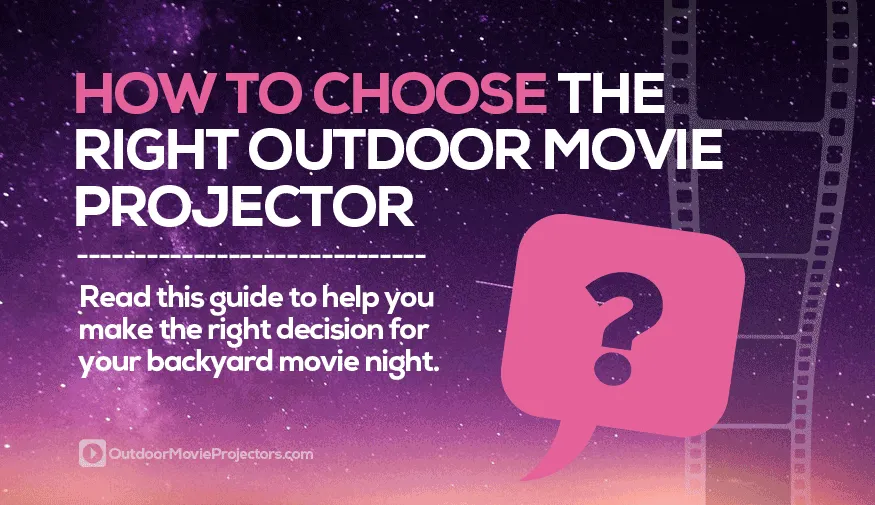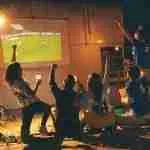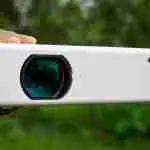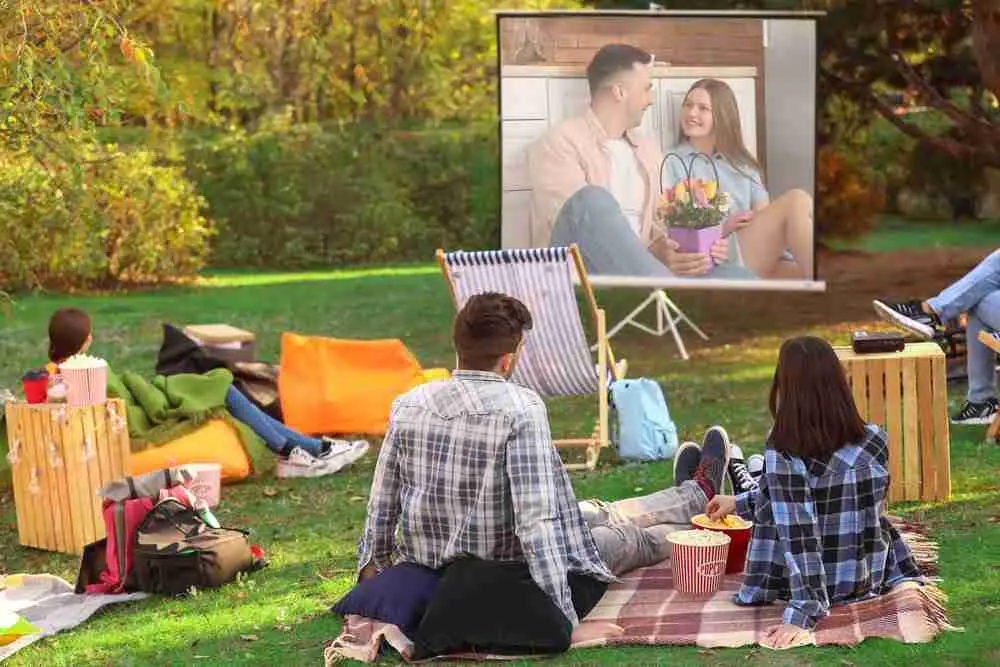Choosing an outdoor movie projector can be very complex and tricky, especially if you are new to backyard movie nights, and don’t know what the differences are or exactly you need.
It doesn’t have to be that way though.
To help you along the way, I have put together guides and recommendations on the types of outdoor movie projectors that are best for backyard movies, and you can go through those products in detail on this link.
However, if you are simply after a quick primer on how to choose the best outdoor movie projector, with my hints and tips on what to look for, then these 13 tips will certainly make your decision-making a whole lot easier. It should take no more than 10 minutes to read, and I promise you, will be more than worth your while.
I hope you enjoy these tips and would welcome any feedback from other outdoor movie enthusiasts who would like to add their own contributions to this guide.
How to Choose an Outdoor Movie Projector
Here are the tips you need to follow if you need help in selecting an outdoor movie projector. They are in no real particular order, so I would recommend that you read every single one to increase your knowledge when choosing a brand and model.
[toc label=”How to Choose an Outdoor Projector: Table of Contents”]
1. Aspect Ratio
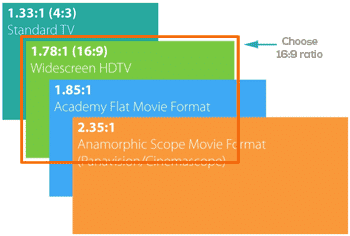
In the description of the outdoor movie projector, you will see some numbers that might look something like 4:3 or 16:9. This is the aspect ratio.
What is a good aspect ratio for a projector?
Opt for a projector with a 16:9 ratio, as this is the modern widescreen format that most films are now produced and filmed at.
However, if you have a thing for 1950s television, then by all means opt for a 4:3 ratio as this is the older-fashioned format!
If you have already purchased an outdoor movie screen (click here if you need suggestions) then it is almost guaranteed that the screen will be at a 16:9 aspect ratio.
It makes sense to not only buy a projector with this format so you can fill the whole screen but it also means you can see the movie in the way in which it was designed to be watched. If you don’t get this right, then you might experience what is called the letterbox or pillarbox effect when watching movies on the screen as is shown in the diagram below.
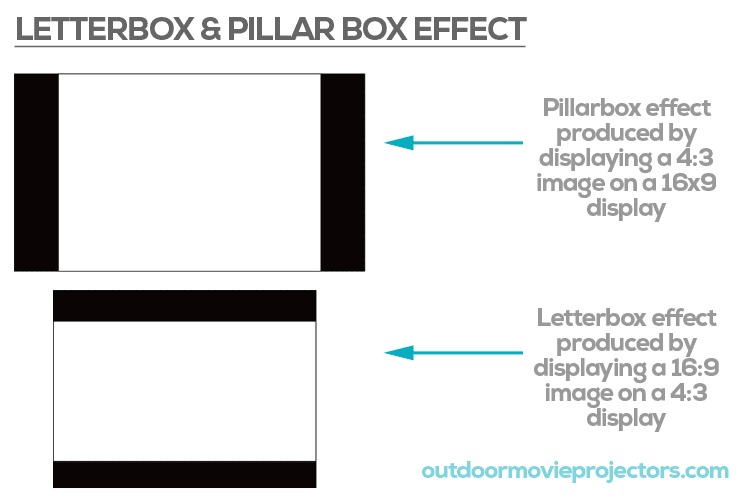
2. Lumens (Brightness)
When shopping around you are going to see a term called “lumens”. But what are they?
In the simplest terms, they relate to how bright the projected image will be, and I’ve put an extensive blog post together if you want to know more about lumen-ratings. You can also scroll to the bottom of this buyer’s guide to see a table displaying various lumen ratings compared to actual screen sizes.
What you need to know though, is how many lumens your outdoor projector needs when choosing what to buy.
If you are showing a movie in a dark room and indoors then one thousand lumens will be enough. However, things get a little bit different when it comes to playing movies in an outdoor environment.
For outdoor movies, you need a projector with at least 3,000 lumens. You will see some advertised that go as high as 6,000 though – do you need to spend that money for backyard movie events?
No, you don’t.
When playing movies in your backyard, 6,000 lumens are overkill, in all honesty, so look for something with a minimum lumen rating of 3,000 at least and you’re good to go.
Projectors that have 6,000 lumens are most commonly used in schools, corporate events, or larger gatherings so in reality are a bit too much for backyard movies.
3. Resolution Type
Resolution is the number of pixels that the projectors used to create the picture. If you have ever stood close to a TV screen or computer monitor, you will see the small dots that make up the image – these are the pixels.
 The more pixels you have, the better the image will be. You ideally want to choose a high-definition HD projector.
The more pixels you have, the better the image will be. You ideally want to choose a high-definition HD projector.
Where this becomes important is when you are projecting an image onto the large outdoor screen. If you have a low resolution, then the movie is going to look blocky and “pixelated”.
But it can become confusing, as your projector might say on the specification that it’s 1080p. But that might not actually mean you are going to get a high-resolution image.
You will need to check to see what the native resolution is as this is the part we are interested in. For a good quality movie watching experience, or if you are looking to watch live sports in your backyard then choose a projector with Full HD (high-definition) native resolution.
Buy a projector that is listed as being Full HD / 1080p or WXGA / 720p. This will be more than enough to watch movies in your backyard at a decent resolution. Full HD is the key here.
4. Bulb or Lamp Life
The bulb is one of the most important aspects of your projector and you will see many brands advertising their products as having 30,000 hours, or 50,000 hours, or 70,000 hours of bulb life.
Is the bulb life important though?
Not really, because let’s get some perspective.
A projector with a stated bulb life expectancy of 30,000 hours equates to almost three and a half years of continuous usage. For example:
- 30,000 hours = 3.4 years
- 40,000 hours = 4.5 years
- 50,000 hours = 5.7 years
With the best will in the world, it’s highly unlikely that you will ever reach that play limit on the bulb’s life. Yes, they can still go wrong, but here’s the thing: you can pick up a replacement bulb for your projector for usually less than $50 should it burn out.
This means, in my opinion at least, that the advertising bulb life expectancy with most modern movie projectors is simply an advertising gimmick where the manufacturers try to make their products stand out from the competition. I wouldn’t be too concerned about it.
It’s really not that important when choosing a projector, as in most cases you will never have to replace it due to usage.
5. Adapters & Ports
The great thing about the latest movie projectors is that they are compatible with most modern media playing devices. This means you can use products as diverse as the following to play movies through the projector:
- USB sticks
- Firesticks
- Flash drives
- External hard drives
- Laptops and Computers
- Smartphones
- Tablets
- DVD players
- BlueRay players
Think about what scenario you will have when planning your outdoor movie night and choose a projector that will accept that type of input or device.
For example, you might want to make sure the one you choose has an HDMI port so you can connect a modern laptop, or even a USB port to connect a drive to play directly from the projector.
The majority of outdoor projectors on the market will have ports for external wired connections meaning you can choose what media player device you use.
Just make sure to check that the projector you are buying is going to be compatible with your chosen device. Projectors with wired connection ports will also tend to be cheaper than ones that come with Wi-Fi wireless connectivity. Which takes us on nicely to…
6. Wireless Connectivity (Wi-Fi)
Over the last few years, there have been some great new additions to the market which offer Wi-Fi connectivity. This eliminates the need for you to connect a playing device using USB, HDMI, cables, or other types of wired port connections.
 This is very similar to how some of the new DVD players that come with Wi-Fi work, where they can stream the content to the projector or screen wirelessly.
This is very similar to how some of the new DVD players that come with Wi-Fi work, where they can stream the content to the projector or screen wirelessly.
The benefit to wireless connectivity is that you can reduce down the amount of wiring and cables in the backyard, but the potential drawback is that you will need a strong Wi-Fi signal is outside – so make sure to check that first.
If you do decide to choose an outdoor movie projector with Wi-Fi capability you will then be able to stream content from services such as Google Chromecast and Netflix, but only as long as you are near a strong Wi-Fi signal.
Movie projectors that come with wireless capability do tend to be more expensive than those with simply wired connections and ports so this will be a price and budget consideration.
7. LCD, LED, or DLP Projection
LED projection versus LCD projection versus DLP projection – what’s best?
DLP is, but you will pay more for the privilege so it all comes down to budget. Having said that, LCD technology has got better in modern times, so let’s take a quick look at the differences between them.
LCD technology first came to the fore in the 1980s and uses liquid crystal displays and a 3-way mirror to cast images onto the screen. Modern LCD projectors do now use updated technology to offer brighter images than they used to, so it’s not as big an issue as it would have been two decades ago.
Outdoor movie projectors that are advertised as being LCD won’t offer as crisp a picture as DLP, but in most cases will be significantly cheaper due to no moving parts or components.
As for DLP projectors, DLP technology uses millions of micro-mirrors that offer highly detailed images projected onto your screen.
Typically, it results in sharper movies with less pixelation when compared to LCD models. The projectors used in movie theaters will be DLP technology for this very reason, but for the home consumer market, you will need to spend more money to take advantage of the benefits.
And as for LED projection?
They tend to have a longer life span and are considered to be more reliable due to them not burning out like a standard lamp or bulb can do. LED projectors also don’t have hazardous mercury in them, making them more environmentally friendly than LCD when it comes to disposal.
LED projectors will also look brighter than LCD as they project a larger number of colors to the screen and can use less energy than lamp-based projectors. But LED projectors aren’t my preferred product for outdoor movies, as they tend not to be as bright, and won’t usually have high lumen ratings.
So still not sure what you should buy?
If you can afford it, go for a DLP projection. Failing that choose LCD, almost every single outdoor movie night I have been to or run myself has used an LCD projector with no problems at all.
8. Sound & Built-in Speakers
The majority of outdoor movie projectors now come with built-in speakers meaning, in theory, you don’t need to hook up any external sound sources.
But that’s all it is. Theory.
Let me tell you why.
The speakers built-in to outdoor movie projectors will be very small, and most of the time be of low wattage. This means you run the risk of having poor audio quality and distortion if you turn the volume right up, or you simply won’t have loud enough volume in the first place.
If your backyard movie is just the two of you, in a private setting, with no other noise pollution, then the speakers that come built-in will probably work just fine.
But, if you are planning on having a backyard movie with more than two guests, kids in attendance, and external noise factors such as traffic and chatter then the built-in speakers probably won’t work that well.
You also might want to factor in the noise emitted from your movie screen. This is an issue with inflatable models as they require you to constantly run an air blower fan to keep them inflated.
The blowers are not massively noisy, especially with the ones that I recommend, but they will still generate a low hum or whir which might not be disguised with the power of your built-in speakers.
So, what should you do?
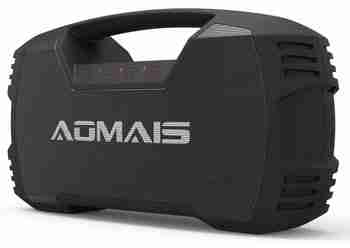 My advice is to not be too concerned with how good the manufacturer states their built-in speakers are because you should always supply an additional sound source anyway.
My advice is to not be too concerned with how good the manufacturer states their built-in speakers are because you should always supply an additional sound source anyway.
Any successful backyard movie night will need external speakers or a soundbar. You can see some of the ones that I recommend including Bluetooth speakers in the recommended gear section.
How this impacts your choice of movie projector is dependent on your technical setup.
For example, some projectors will only have an audio-in port. To connect up speakers to the projector you will need an audio-out port.
But don’t let this put you off.
The reason I say that is because you could instead connect the speakers to your media playing device, which is bound to have an audio-out port. For example, if playing via a laptop, you would simply plug the speakers into the computer.
To summarize, don’t worry too much about the speakers and wattage advertised on your chosen movie projector.
If you are going to run a backyard movie night, then you instead will be using external speakers, or a soundbar plugged into the projector or player. Alternatively, you can use wireless speakers to get the desired volume levels.
9. Size and Portability
Once you have successfully put on your first backyard movie night, I can almost guarantee that your guests will be asking you to host an event round at their place in the future.
It comes with the territory, believe me!
With that in mind, it might pay to find a movie projector that is lightweight and portable, preferably with a carry case.
Gone are the days when you would have to wheel a movie projector out on a trolley, and need massive abs in order to carry it around. Modern projectors are getting progressively smaller and lighter by the year.
Most products you see will be portable but take a look at how much they weigh and ask yourself if that’s an acceptable size for your own plans.
10. Brand and Manufacturer
Is the brand name important when buying or choosing an outdoor movie projector?
Not always.
There are some amazing new projectors on the market right now that are just as good as the big-name brands. There has been an explosion in Chinese manufacturers developing projectors that stand up very well against the big names.
But for me, I do like to choose a well-known brand, because it can give you peace of mind in knowing that if anything goes wrong, you should be able to get support to fix any problems.
Choosing a well-known manufacturer will undoubtedly mean that they have a customer service and support team already in place who can help you with problems or returns.
In most cases, it also means that if you have bought a best-selling projector, there will probably be websites such as this one where you can find trouble-shooting guides and online problem-solving forums that have already answered your support question.
My experience of buying the lesser-known projector brands is that where they are so new and from a smaller company, there sometimes will be very little in the way of online support available – both from independent bloggers and the actual manufacturer themselves.
So, my advice?
Try to buy a well-known brand and future-proof yourself against any possible returns or support issues and give yourself the comfort that you should be able to find answers to issues online.
11. Read Online Reviews
Websites such as this one contain a huge amount of independent information on the wide range of backyard movie projectors available. We ourselves regularly buy and review the latest products in the market to help you in making an informed choice.
It can be hard though to find legitimate and authentic product reviews online, as there are many websites that won’t have even bought the product, but simply review them in order to get a commission on a referred sale.
My advice is to look on a website such as Amazon and look for an outdoor projector that has at least 300 reviews.
This means that it has probably sold in thousands, and so gives you an opportunity to read not just reviews, but also questions and answers from other people considering a purchase.
When looking at Amazon user reviews, take more notice of the ones which have the “verified purchase” label next to them – this means the person genuinely bought the item and so their review can be taken more honestly.

With any product, you are going to see both bad and good reviews, so as a rule of thumb, try to buy something that has 4 stars out of 5 at least, and at least 300 reviews. That should give you a very fair assessment of how good the projector actually is from a consumer perspective.
12. Price and Cost
If planning a backyard movie night, I would recommend you look to buy a projector that is at least $300 – that should give you a product that will last and can be used time and time again.
It’s certainly my sweet spot at the lowest end of the pricing spectrum and should let you buy something with a high enough lumen rating to watch movies outdoors, as well as a decent HD resolution and port connectivity.
As a general rule, the more you pay, the better you get, and this is so true with movie projectors.
You can pick up small mini-projectors for less than $100, but they aren’t really going to cut it if you have more than a couple of people watching, and are using a larger screen. Here’s a recent review I did of a very cheap mini-projector.
If you want something that is really going to project large images onto a large screen, then that will cost you, and the lumens will start to increase. You can see a table in the next tip which shows how lumen ratings can affect your projected image size which will help you in choosing the best outdoor projector to suit you.
13. Measure Up and Plan Your Available Space
How much space you have in your backyard, how you plan the seating, and your projector screen size is going to be very key to the type of projector that you buy.
Firstly, let’s start with your screen size. The table below shows you how many lumens your projector will need depending on how large your screen is.
| Screen Size | Minimum Lumen Needed | Ideal Lumens Needed |
|---|---|---|
| 9x5 foot | 1,500 | 2,300 |
| 12x7 foot | 2,300 | 3,000 |
| 16x9 foot | 3,000 | 4,500 |
| 20x11 foot | 4,500 | 7,500 |
| 25x14.5 foot | 5,000 | 10,000 |
| 40x22.5 foot | 5,500 | 12,000 |
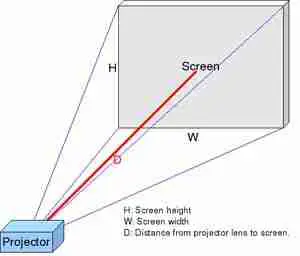
You might also see the term “throw distance” used when shopping for outdoor projectors. This relates to what size of the image you can get depending on the distance between the projector and screen.
When looking at outdoor projectors, they will have a number in the specification which might look something like 1.5:1.
This means you need your projector to be 1.5 feet away from the screen in order to project 1 foot of width.
For most backyard parties it’s not essential to be on top of this information, but it can help to optimize the viewing experience, so certainly something to be aware of if you are going to be taking your new hobby seriously.
And Finally, Some Projector Recommendations
I hope this has helped you when knowing what to look for when buying a projector.
If you need some advice on what to buy, then I’ve taken all trouble away for you if you want to know how to choose an outdoor movie projector.
Click into my recommended gear page where you can see some very quick links into my favorite outdoor movie projectors which should help you to choose which one you want to buy today.
Many of them are ordered in price brackets to suit your budget, and all of them tick most of the boxes I would be considering when looking to choose a projector for a backyard movie night.
